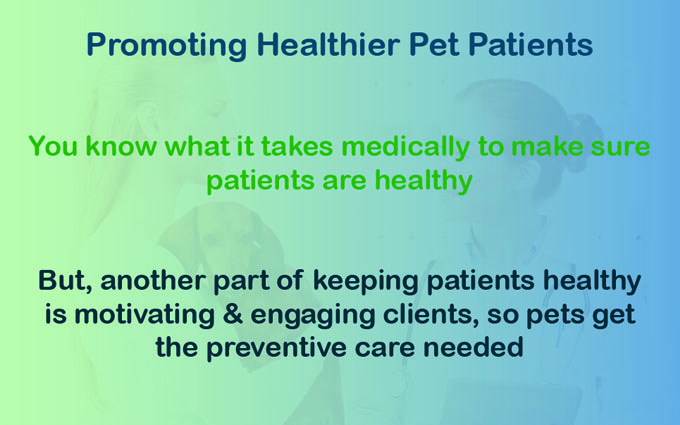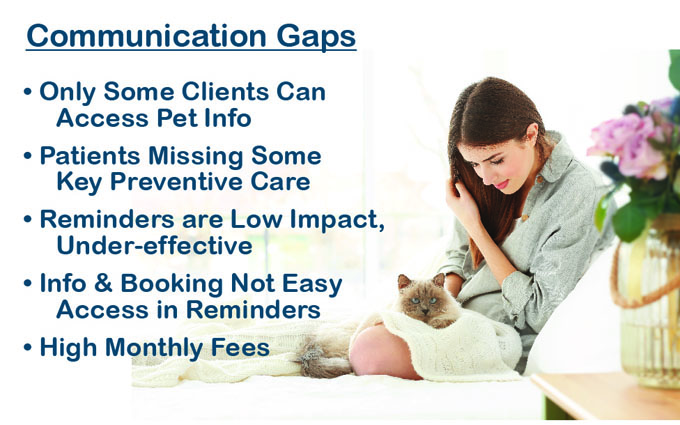Key Insights
There are many places and ways experts point to, for providing clients with information about the preventive care of their pets: crucial brief in-clinic conversations, posters/handouts, on the website, social media and now in the portal/app.
- A Group Effort–Improving Client Education & Compliance — Dr. Amanda Donnelly.
Dr. Donnelly, veterinary client communications expert and VetPartners consulting organization member, advises that client education and patient preventive-care engagement begin with in-clinic interactions, management and training. As she says: “Don’t assume what clients know”. She then outlines steps for staff training and alignment around preventive health. - Educate Your Clients on the Value of Preventive Care Diagnostics — Sandy Walsh, RVT, CVPM.
Sandy is a practice management consultant and VHMA and VetPartners consulting organization member. She asserts that interaction with the client from first visit through each follow-up is the best way to educate/inform the client about preventive care and emphasize the importance of preventive care for the health of the owners pet(s). But, Sandy also how you can continue and reinforce the preventive-care education conversation… on the website, the practice portal/app and in social media. - Client Education: a Vital Role for Veterinary Technicians — Penn Foster Blog (Emma Rose Gallimore).
Another commentary pointing to the importance of involving veterinary technicians (and we would add, other members of the vet staff) in educating clients about important preventive care for their pet(s). - 3 Pointers for Parasite Prevention Education and Broaching Parasite Preventives with Clients — Beckie Mossor, RVT, Julia Burke Assistant Editor DVM 360.
Ms Mossor also focuses on in-clinic client education, briefly discussing how important it is to try to understand the client’s mindset and knowledge, before deciding what preventive health guidance to offer. - DVM360 Toolkits: e.g. DVM360 Toolkit for Heartworm Disease, and DVM360 Vaccines Toolkit.
For selected client education topics, DVM360 has put together toolkits that help train staff with communication tactics for discussing key preventive care topics with clients. They also include handouts and social media post messaging that the practice can use. - Client Education Materials — AVMA and Steal These Veterinary Client Handouts! — DVM360.
There are many sources that promote preventive care client education through the use of handouts and posters in-clinic. AVMA and DVM360 are just 2. LIfeLearn and VIN are 2 other subscription services that include handouts and website content covering preventive care topics. - 5 Ways to Ramp Up Your Veterinary Practice’s Client Education Game — VetSource Blog; and, Client Education Through Online Videos or Online Classes — MWI Blog (Roxanne Hawn)
But, as these commentators suggest, client education can and should be readily available beyond the clinic. Websites are clearly the most common place to make client education available to clients. (videos are an increasing popular way to engage clients and help them understand the preventive care of their pets)
While In-clinic education, by your full vet team, is the main point for client education. The in-clinic time is often limited. Website-base preventive care education is an important way to provide on-demand access to information about various preventive care topics.
Now you can incorporate client education as part of many pet portals/apps. It can be most relevant and impactful if you can tell clients what your Standard of Preventive Care vaccines and services are, in your pet portal/app. This lets them (a) see which of your recommended preventive care has been set up for each of their pets, and what preventive care should/might be added, and (b) lets them get answers, right at that point, about why each of your recommended vaccines, tests and services are important to the health of their pet.




